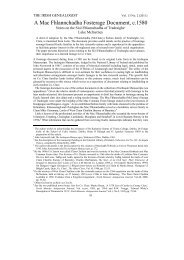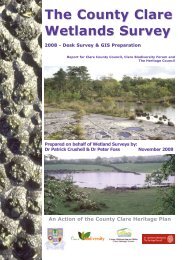Documents from the Thomond Papers at Petworth House Archive1 ...
Documents from the Thomond Papers at Petworth House Archive1 ...
Documents from the Thomond Papers at Petworth House Archive1 ...
You also want an ePaper? Increase the reach of your titles
YUMPU automatically turns print PDFs into web optimized ePapers that Google loves.
<strong>Documents</strong> <strong>from</strong> <strong>Thomond</strong> <strong>Papers</strong>, <strong>Petworth</strong> <strong>House</strong> Archive<br />
ship of his lands forfeit to <strong>the</strong> fourth Earl of <strong>Thomond</strong>. The document,<br />
written in 1636, recalls <strong>the</strong> incident in 1616 with <strong>the</strong> chief purpose of ascertaining<br />
proprietorship of <strong>the</strong> land. Four deponent st<strong>at</strong>ements are given, <strong>the</strong><br />
most detailed being Mahowne McGillowoile’s and Thomas McRedmund’s<br />
st<strong>at</strong>ements which are in general agreement. The st<strong>at</strong>ement of ‘fflan O Neil’<br />
crystallises a personal fact of <strong>the</strong> incident; <strong>the</strong> pleas of Daniel Annierie<br />
McNemarra’s wife for relief of her husband imprisoned <strong>at</strong> Ennis.<br />
The document highlights <strong>the</strong> administr<strong>at</strong>ion of law in Co. Clare. For<br />
example, when McNemarra was found with <strong>the</strong> stolen horses he was<br />
brought immedi<strong>at</strong>ely before a justice of <strong>the</strong> peace and imprisoned. It<br />
appears th<strong>at</strong> <strong>the</strong> stolen horses left a track across Mahon McEnerhiny’s<br />
land which facilit<strong>at</strong>ed <strong>the</strong> loc<strong>at</strong>ion of <strong>the</strong> horses and led to McNemarra’s<br />
apprehension. McNemarra must have appeared before an assize where<br />
evidence was given against him and th<strong>at</strong> it was <strong>the</strong> seneschal of <strong>the</strong> earl<br />
of <strong>Thomond</strong>’s Bunr<strong>at</strong>ty manor, Captain Norton, who repossessed <strong>the</strong> land<br />
<strong>at</strong> Drumquin and parcelled it out to <strong>the</strong> tenants of <strong>the</strong> earl.<br />
Forfeiture of land for a crime was not uncommon and o<strong>the</strong>r examples<br />
can be identified in <strong>the</strong> <strong>Thomond</strong> papers. Take, for example, PHA Ms<br />
C.13/35 (d<strong>at</strong>ed 1619) which st<strong>at</strong>es th<strong>at</strong> James McInnerreny, who held <strong>the</strong> half<br />
quarter of ‘Cnock I Sl<strong>at</strong>try’ (Knocksl<strong>at</strong>try, Doora pairsh), a mill adjoining<br />
Dromoland and <strong>the</strong> half quarter of Ballykilty called Leacerrone Iraghteragh<br />
(Tomfinlough parish) was found guilty of man-slaughter for <strong>the</strong> killing<br />
of James Dixon who was part of Sir Robert Mcleanan’s company. 95 This<br />
alterc<strong>at</strong>ion would have placed James McInnerreny’s lands <strong>at</strong> risk of forfeiture<br />
to his overlord, <strong>the</strong> earl of <strong>Thomond</strong>. Perhaps on account of James’<br />
literacy and <strong>the</strong>refore his right to claim benefit of clergy, 96 or because of<br />
record for Ennis and Quin. Some early seventeenth century officials regarded <strong>the</strong> holding<br />
of assizes in Co. Clare an inconvenience, resulting in prisoners escaping <strong>from</strong> jails and th<strong>at</strong><br />
<strong>the</strong> ‘Commissioners have been driven to keep <strong>the</strong>ir assizes in an open abbey’ [i.e. Ennis<br />
Friary]. J.S. Brewer & William Bullen Esq. (eds), Calendar of <strong>the</strong> Carew Manuscripts Preserved<br />
in <strong>the</strong> Archiepiscopal Library <strong>at</strong> Lambeth, 1601–1603,(London, 1870), pp 171 & 173. James Frost<br />
mentions th<strong>at</strong> <strong>the</strong> English established a jail <strong>at</strong> Ennis in 1591 and th<strong>at</strong> after <strong>the</strong> rebellion by<br />
Mahon O’Brien of Clondovan in 1586, seventy people were put to de<strong>at</strong>h <strong>at</strong> one assize. James<br />
Frost, A History and Topography of <strong>the</strong> County of Clare, p. 251. On <strong>the</strong> Ennis jail see Risteárd<br />
Ua Cróinín & Martin Breen, ‘The hidden towers’ in The O<strong>the</strong>r Clare, xvi (1992), pp 5–10.<br />
95 ‘Inform<strong>at</strong>ion about Land out of my Lords hands, No.32, Wm Brickdall’ no d<strong>at</strong>e (PHA Ms<br />
C.13.35). Leacerrone Iraghteragh was recorded as Lecaroweighter in 1641 and formed part of<br />
Ballykilty. R. Simington, Books of Survey and Distribution, p.152. Sir Robert Mcleanan’s (recte,<br />
McLellanne) suffered o<strong>the</strong>r set backs in Co. Clare, including an <strong>at</strong>tack by ‘eight or nine<br />
gentlemen and freeholders of <strong>the</strong> sept of Macnamara who killed one and severely wounded<br />
ano<strong>the</strong>r’ of his company in 1628. Calendar of <strong>the</strong> St<strong>at</strong>e <strong>Papers</strong> rel<strong>at</strong>ing to Ireland of <strong>the</strong> Reign<br />
of Charles I, 1625–1632, Robert P. Mahaffy, (ed.) (London, 1900), p. 371.<br />
96 See John Ainsworth (ed.), The Inchiquin Manuscripts, No.983, pp 312–313 and No.1481,<br />
pp 504–505. These references rel<strong>at</strong>e to <strong>the</strong> lands held by Conor O’Brien of Dromoland<br />
(d. 1603) with <strong>the</strong> l<strong>at</strong>ter mentioning ‘John McEnerhyny, ‘prist’ (sic) and James his son, for<br />
which <strong>the</strong>y have a quarter of Dromolin in mortgage’. The former reference refers to a grant<br />
to James McEnerhine of 4 acres in R<strong>at</strong>hfolan by Conor O’Brien prior to 1603. In 1619 in an<br />
23

















